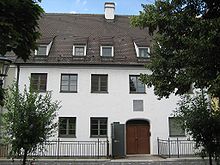Günther Strupp
Günther Strupp (born March 6, 1912 in Johannisburg [then East Prussia , now Poland ], † November 14, 1996 in Augsburg ) was a German painter and graphic artist .
life and work
Strupp was born in 1912 in Johannisburg (today Pisz ) in Masuria . His father was a Prussian surveyor. In 1914 his mother fled to Westphalia with him and his sister from the chaos of war. They returned in 1917. After his father was transferred to Duisburg in 1922, Strupp lived with an uncle in Paderborn, where he attended high school. At 17 he left it and began an apprenticeship in glass painting for a year and a half . From 1930 to 1933 he studied art at the Folkwang School . There he was a student of Karl Rössing and Hein Reckroth , a friend of Heinz Kiwitz .
In 1933 Strupp joined the Communist Party of Germany and was therefore arrested immediately after the National Socialists came to power . He was held for several months in the Kemna concentration camp near Wuppertal . When he was released in 1933, he moved to Paris , where he was safe from the Gestapo . In 1936 his passport expired and he was deported to Germany. In addition to his artistic activity, he worked as a glass painter. His work in the 1920s and 1930s was based on his models such as Otto Dix or George Grosz .
In 1937 he painted Germanic snake ornaments in Osnabrück for the large glass windows of the Bochum crematorium, which was destroyed by fire during the war.
In 1939 he was retrained as a draftsman together with other painters and graphic artists. As a soldier he served in Crossen together with Walter Scherf , who later became a fairy tale researcher, before he was dismissed from military service due to his unfit for military service. In 1940 he was hired as a set designer at the Schillertheater in Berlin on the mediation of Wilhelm Fraenger . In 1943 he went to Augsburg , where he felt safer. Strupp was arrested by the Gestapo in 1944 because of the deterioration in military strength and contacts with resistance groups. He was taken to death row in Stadelheim in Munich , where he was liberated by the US Army on May 1, 1945 .
He returned to Augsburg and drew for the satirical magazine Ulenspiegel . In the 1950s he developed his distinctive caricature and comic style. He primarily addressed the suffering of the war and the Nazi era.

In 1965 he was housed by the city in the rebuilt Holbeinhaus , which had been completely destroyed in the war - as a kind of "better caretaker" or "night watchman from the Holbeinhaus", as he himself put it. His first work created here was the "Böwe-Bild", a commission from Maschinenfabrik Böhler & Weber. The picture, a chipboard painted with casein paints, is about two and a half meters wide and 120 centimeters high, the time required for this was 185 days, without preparation or rework. Strupp has calculated that around 3½ million brushstrokes were necessary for the picture. According to the painter's style, it consists of innumerable individual motifs that represent or symbolize events, products and people of the company, as well as hiding “some of the painter's privacy”. Strupp later wrote about his work: “The painter of the BÖWE picture has vowed to paint pictures in the BÖWE art only for three times the price, or not at all, for the simple reason that the painter is still working on the Wants to preserve life ”.
Until his death he had his studio in the Holbeinhaus.
Exhibitions (selection)
- Exhibition Heinz Kiwitz , Günther Strupp , Galerie Oberstenfeld, Duisburg (September 27 - October 26, 1947)
- Günther Strupp: Tempera and oil paintings, drawings 1930-1960 , Köln Kunstverein (July 30 - August 28, 1960)
- Three generations of Strupp , Temporary Gallery, Munich 2004 (including works by his son Peter and his granddaughter Sabina Sakoh , née Niederkofler)
Publications, works
- Ludwig Tieck, Günther Strupp, Strange Life Story, Sr. Majesty Abraham Tonelli , W. Rau (1947)
- Günther Strupp, This is how we live !: Listening to fur animals , Rifra-Verlag (1954)
- Painting and graphics by Günther Strupp, 1930 to 1960 , Verlag Die Brigg (1961)
- Jella Lepman, Hansjörg Schmitthenner, Günther Strupp, The most beautiful good night stories , Ullstein (1964)
- Günther Strupp, The night watchman from the Holbein House , Verlag Die Brigg (1967)
- Henryk Keisch, hosiery. Günther Strupp's curious, unhealthy world of images , Eulenspiegel Verlag (1970)
- Herbert Sandberg, Günther Strupp, Günther Strupp 70 Years (1982)
- Large wall painting for the machine factory Böhler & Weber (Böwe) (1965)
- Regular publications and work by and for the magazine Die Pelzmotte , Rifra-Verlag
Web links
- Literature by and about Günther Strupp in the catalog of the German National Library
Individual evidence
- ↑ a b c d Verlag Die Brigg, Augsburg: Struppzeug. The night watchman from the Holbein House . Leaflet, undated (c. 1971).
- ↑ a b companions: Günther Strupp Wilhelm-Fraenger-Gesellschaft e. V. Accessed February 10, 2012
- ^ Günther Strupp: Böwe-Bild 1965/66 (Maschinenfabrik Böhler & Weber) Augsburg. Description of the picture . Leaflet, January 13, 1968.
- ^ "Three Generations Strupp" , Münchner Wochen Anzeiger (June 6, 2002). Retrieved April 18, 2014
- ↑ Books by / about Günther Strupp Google.de Retrieved on February 10, 2012.
- ↑ www.ziermann.com: The painting for the machine works BÖHLER & WEBER (BÖWE) […] . Retrieved August 24, 2016.
| personal data | |
|---|---|
| SURNAME | Strupp, Günther |
| BRIEF DESCRIPTION | German painter and graphic artist |
| DATE OF BIRTH | March 6, 1912 |
| PLACE OF BIRTH | Berlin |
| DATE OF DEATH | November 14, 1996 |
| Place of death | augsburg |
